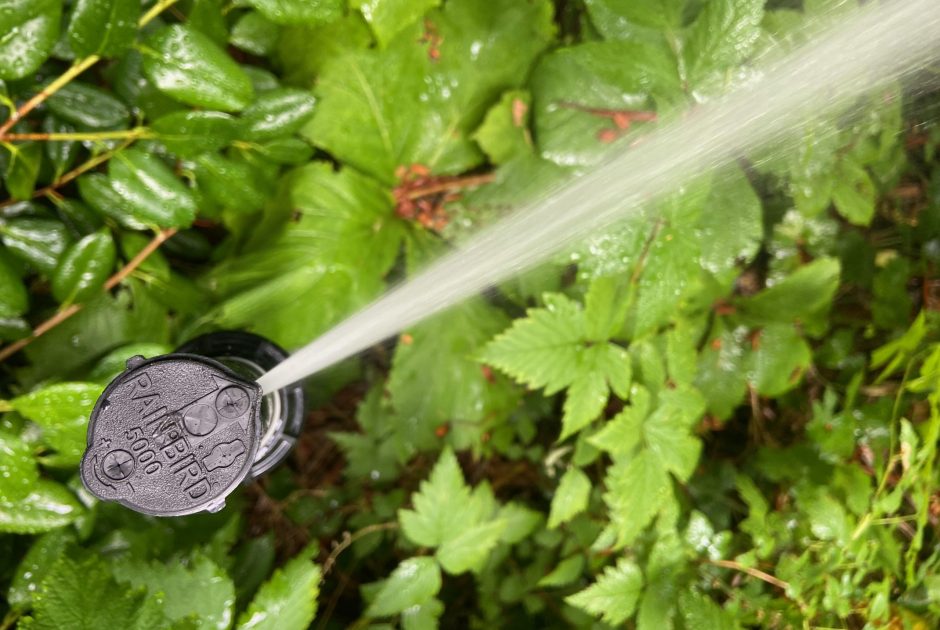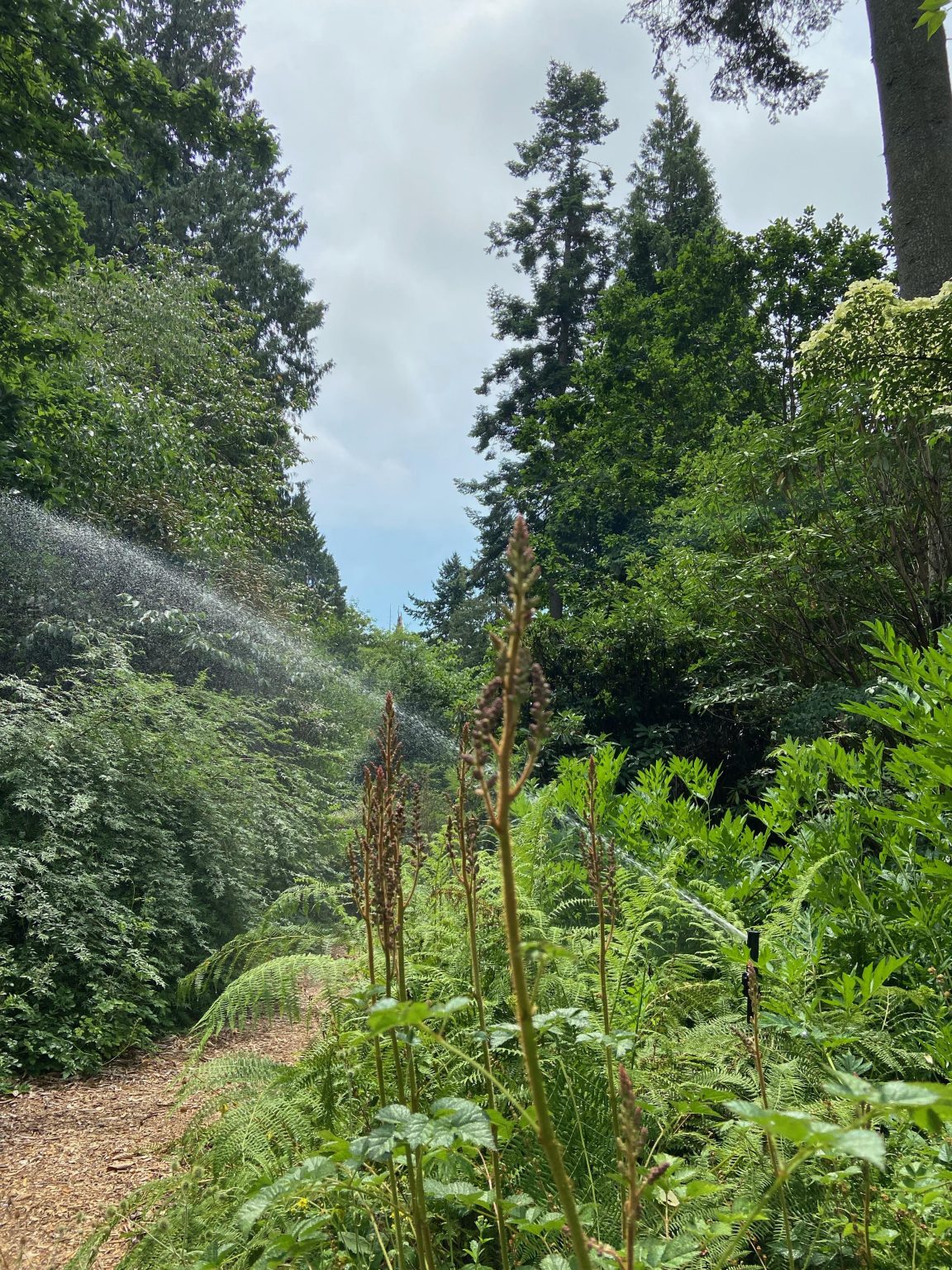Douglas Justice, Associate Director (Horticulture & Collections) discusses the importance of water use to maintain healthy collections and promote biodiversity, highlighting the newly instated irrigation systems at both UBC Botanical Garden and Nitobe Memorial Garden.

Sprinkler in the Garden. Photo by Andy Matheson, Horticulturist.
Water use has always been a significant issue in the Garden. Our shallow, fast-draining soils are quickly depleted of moisture as temperatures warm in late spring. Without irrigation, most of the collections would be lost or irreparably damaged. One of our most important water conservation initiatives is the upgrading of irrigation systems throughout UBC Botanical Garden and Nitobe Memorial Garden.
Upgrades to Irrigation Systems in the Gardens
Prior to the installation of our new systems, the Garden’s older irrigation networks were aging and leaking, and most were seriously under-designed, leaving us with many dry areas. To make do, inefficient portable and jury-rigged systems had to be set up.
It’s important to note that some plants can survive through summer drought and not all collections require the same amount of moisture. Turf grasses are a notable example. In areas where we can afford to, summertime lawn watering is curtailed. Typically, a lawn will bake to a light russet brown, but green up quickly with the return of the rains in autumn.

Water irrigation system in the David C. Lam Asian Garden. Photo by Andy Matheson, Horticulturist.
But many specimens require specific water treatment in summer, including our collection of large-leaved rhododendrons, maples, ferns and assorted Asian exotica in the David C. Lam Asian Garden. Most are mountain-dwelling plants that are adapted to cool temperatures, humidity and a summer monsoon—quite the opposite of Vancouver’s summer conditions. Similarly, Nitobe Memorial Garden requires frequent, if restrained, watering to keep it looking mossy and true-to-design. Even the trees and shrubs in our Carolinian Forest Garden are adapted to summer rainfall. Without summer irrigation, all of these plants would quickly exhaust the paltry reservoir of water in the soil and decline or die.
Now, however, we have two modern, well-designed irrigation systems, including appropriate valves and piping, efficient sprinkler heads and remote electronic timers. The more extensive of the two systems is in the Asian Garden, while the other system is in Nitobe Memorial Garden. Both systems were made possible by generous donations.
We’re not done yet, but these new systems have already significantly reduced water use and labour, and our collections have benefited enormously.

Photo by Andy Matheson.

Photo by Andy Matheson.

Photo by Andy Matheson.
Horticultural Initiatives to Conserve Water
Another key sustainability initiative is our focus on nurturing water-conserving landscapes such as the Garry Oak Meadow Garden, a representation of a local rain-shadow ecosystem. Here, we grow plants adapted to open, sunny slopes and meadows. A high proportion of the plants are deep-rooted trees and shrubs, grasses and summer-dormant bulbs that need little or no irrigation once established.

Great camas in the Garry Oak Meadow Garden. Photo by Douglas Justice, Associate Director, Horticulture & Collections.

Pond in the E. H. Lohbrunner Alpine Garden. Photo by Laura Caddy, Curator, Alpine Garden.
The Garry Oak Garden, like all other areas of the Botanical Garden, provides ecosystem services, such as clean air and water, carbon storage and healthy habitats. Many of these services support biodiversity. Garden staff pay particular attention to maintaining habitats and microhabitats for the wide variety of organisms in the Garden, and we see the results in increasing diversity of wildlife and overall health of the Garden areas.

Pond in the David C. Lam Asian Garden.

Pond in Nitobe Memorial Garden.
The availability of water is fundamental to the preservation of biodiversity. While there are no naturally occurring permanent waterbodies on campus because of the nature of the soil, we make every effort to slow down and retain the water that passes through the Garden. This could be stormwater that originates somewhere else on campus, water from our own irrigation systems or the water we collect in artificial ponds. As this latest heat wave amply shows, water is a precious resource that we cannot afford to waste.
Submitted by: Douglas Justice, Associate Director, Horticulture and Collections

Hi Nancy, thank you for your great suggestion! We’ve forwarded your idea to our team so that they know there is interest in water conservation “walk & talks” at the Garden. Stay tuned!
Very interesting! Are you planning any ‘walk & talks’ for gardeners like me who are interested in the new systems in these two gardens? My huge old trees and rhododendrons on my large up and down and spread out lot on the North Shore are really suffering. No built-in irrigation! What to do now that is water efficient as we are experiencing climate change has to be foremost in many minds.